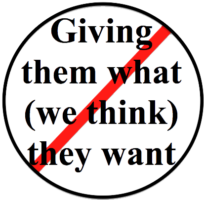 There are, of course, many things that community engagement is not. High on that list is “a magical elixir to cure all of the nonprofit arts industry’s ills.” At best it can position organizations for greater viability by significantly increasing donor and attendee reach. That comes to pass by being seen as valuable by much larger percentages of the population than is the case at the moment.
There are, of course, many things that community engagement is not. High on that list is “a magical elixir to cure all of the nonprofit arts industry’s ills.” At best it can position organizations for greater viability by significantly increasing donor and attendee reach. That comes to pass by being seen as valuable by much larger percentages of the population than is the case at the moment.
Addressing more common and smaller issues, engagement need not be expensive (especially at the beginning) or “charity work” or code for “diversity” or any of a number of other things that critics ascribe to it. But the rant du jour here is about my old nemesis “pandering.” I get wound up about this a good deal (including The “Pandering” Straw Man and R E S P E C T), but it’s been a while now and so I thought it was time to briefly revisit this hoary old chestnut. Here is my go-to statement about the issue.
Community engagement is not “giving them what (we think) they want.” It does demand learning enough about “them” to know what work of the international cultural canon will be meaningful to them. And then programming that with them.
The notion that anyone would take a poll of what orchestral works or plays or paintings or ballets a community unfamiliar with the art form wants and then program that is or should be ludicrous. It would be artistically irresponsible. It would also be, if I may say, disrespectful of the community (assuming that they couldn’t possibly be moved by works they don’t know) and, not to put too fine a point on it, lazy. True engagement, learning about new communities, is without a doubt time consuming on the front end. It takes work.
But more than work, it takes commitment, belief, and respect for communities and the process of building relationships with them. With those basic building blocks engagement is possible and its benefits attainable.
Engage!
Doug

“Community engagement is not “giving them what (we think) they want.”
Here you seem to be talking about the creation of a work of art or play or music. If I read you correctly you are saying that artists should not just be reduced to making things the “community” says they want.
“It does demand learning enough about “them” to know what work of the international cultural canon will be meaningful to them. And then programming that with them.”
But here you seem to be suggesting the opposite?
Now you seem to have shifted from talking about the making of the work of art to the “programing” of works of art?
If not’s not such a good thing to make work that the audience says they want. (which I believe it isn’t. Art doesn’t work that way), then how can it be a good thing to give them a program of work that you are letting them program?
As I have responded to you numerous times before, I am almost never speaking to artists about what they should or should not do. This is about arts organizations, their attitudes toward community engagement, and their choices with respect to programming.
And the attitudes of arts organizations regarding what they program and what they choose to support and who they choose to support, effect artists everyday.